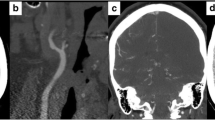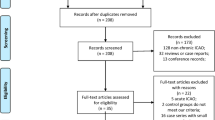Abstract
Purpose of Review
Acute internal carotid artery occlusion (ICAO) is associated with high rates of morbidity and mortality, whereas chronic ICAO can present insidiously with recurrent strokes. In this review, we discuss the medical and surgical management approaches among patients with acute, subacute, and chronic ICAO.
Recent Findings
We reviewed the recent literature regarding clinical presentation of acute and chronic cases of ICAO, and discuss the current data, accepted guidelines, and prospects.
Summary
Surgical, endovascular, or a combination (hybrid) revascularization has been shown to be effective in recanalization with improved functional outcomes in patients with ICAO in comparison to systemic thrombolysis or medical therapy alone. Future prospective or randomized clinical trials are warranted to elucidate the procedural superiority for revascularization of patients with ICAO.

Similar content being viewed by others
References
Papers of particular interest, published recently, have been highlighted as: • Of importance •• Of major importance
Malhotra K, Gornbein J, Saver JL. Ischemic strokes due to large-vessel occlusions contribute disproportionately to stroke-related dependence and death: a review. Front Neurol. 2017. https://doi.org/10.3389/fneur.2017.00651.
Clagett GP, Faught WE, van Bemmelen PS, Mattos MA, Hodgson KJ, Barkmeier LD, Ramsey DE. Presentation and natural history of internal carotid artery occlusion. J Vasc Surg. 1993;18:512–24.
Malhotra K, Goyal N, Tsivgoulis G. Internal carotid artery occlusion: pathophysiology, diagnosis, and management. Curr Atheroscler Rep. 2017. https://doi.org/10.1007/s11883-017-0677-7.
Malhotra, Liebeskind. Collaterals in ischemic stroke. In: Malhotra, Konark; Liebeskind, David S. | download. https://ur.booksc.eu/book/80863057/ddc2de. Accessed 23 Sep 2021.
Rubiera M, Ribo M, Delgado-Mederos R, Santamarina E, Delgado P, Montaner J, José A-S, Molina CA. Tandem internal carotid artery/middle cerebral artery occlusion. Stroke. 2006;37:2301–5.
Kim DJ, Kim DI, Byun JS, Jung JY, Suh SH, Kim EY, Heo JH. Intra-arterial thrombolytic therapy for hyperacute ischemic stroke caused by tandem occlusion. Cerebrovasc Dis. 2008;26:184–9.
Ozdemir O, Bussière M, Leung A, Gulka I, Lee D, Chan R, Spence JD, Pelz D. Intra-arterial thrombolysis of occluded middle cerebral artery by use of collateral pathways in patients with tandem cervical carotid artery/middle cerebral artery occlusion. Am J Neuroradiol. 2008;29:1596–600.
Persoon S, Luitse MJA, de Borst GJ, et al. Symptomatic internal carotid artery occlusion: a long-term follow-up study. J Neurol Neurosurg Psychiatry. 2011;82:521–6.
Kim SM, Woo HG, Kim YJ, Kim BJ. Blood pressure management in stroke patients. J Neurocrit Care. 2020;13:69–79.
•• Goyal N, Tsivgoulis G, Pandhi A, et al. Impact of pretreatment with intravenous thrombolysis on reperfusion status in acute strokes treated with mechanical thrombectomy. J NeuroIntervent Surg. 2019;11:1073–1079. IVT is associated with lower rates of recanalization in patients with AIS due to proximal large vessel occlusion; however, use of IVT prior to EVT is associated with increased rates of successful reperfusion, reduced total number of device passes, reduced duration of the procedure, and improved mRS scores.
Katsanos AH, Malhotra K, Goyal N, et al. Intravenous thrombolysis prior to mechanical thrombectomy in large vessel occlusions. Ann Neurol. 2019;86:395–406.
Lin MP, Tsivgoulis G, Alexandrov AV, Chang JJ. Factors affecting clinical outcome in large-vessel occlusive ischemic strokes. Int J Stroke. 2014;10:479–84.
Mokin M, Kass-Hout T, Kass-Hout O, Dumont TM, Kan P, Snyder KV, Hopkins LN, Siddiqui AH, Levy EI. Intravenous thrombolysis and endovascular therapy for acute ischemic stroke with internal carotid artery occlusion. Stroke. 2012;43:2362–8.
Paciaroni M, Inzitari D, Agnelli G, et al. Intravenous thrombolysis or endovascular therapy for acute ischemic stroke associated with cervical internal carotid artery occlusion: the ICARO-3 study. J Neurol. 2014;262:459–68.
Castro-Afonso De, Henrique L, et al. Endovascular reperfusion for acute isolated cervical carotid occlusions: the concept of ‘hemodynamic thrombectomy’. Interventional Neurology. 2018;8(1):27–37. https://doi.org/10.1159/000493021.
Jovin Tudor G, et al. Emergent stenting of extracranial internal carotid artery occlusion in acute stroke has a high revascularization rate. Stroke. 2005;36(11):2426–2430. https://doi.org/10.1161/01.str.0000185924.22918.51.
Paciaroni M, Bogousslavsky J. Antithrombotic therapy in carotid artery stenosis: an update. Eur Neurol. 2014;73:51–6.
EC/IC Bypass Study Group. Failure of extracranial–intracranial arterial bypass to reduce the risk of ischemic stroke: results of an international randomized trial. N Engl J Med. 1985;313(19):1191–200.
Gertler JP, Cambria RP. The role of external carotid endarterectomy in the treatment of ipsilateral internal carotid occlusion: Collective review. J Vasc Surg. 1987;6:158–67.
A; OKO [JET study (Japanese ec-ic Bypass Trial)]. In: Nihon rinsho. Japanese Journal of clinical medicine. https://pubmed.ncbi.nlm.nih.gov/17461199/. Accessed 23 Sep 2021.
Grubb RL, Powers WJ, Derdeyn CP, Adams HP, Clarke WR. The carotid occlusion surgery study. Neurosurg Focus. 2003;14:1–7.
Group EIBS. Failure of extracranial-intracranial arterial bypass to reduce the risk of ischemic stroke: results of an international randomized trial. N Engl J Med. 1985;313:1191–200.
Powers WJ, Clarke WR, Grubb RL, Videen TO, Adams HP, Derdeyn CP, COSS Investigators for the. Extracranial-Intracranial bypass surgery for stroke prevention in hemodynamic cerebral ischemia. JAMA. 2011;306:1983.
Fluri F, Engelter S, Lyrer P. Extracranial-intracranial arterial bypass surgery for occlusive carotid artery disease. Cochrane Database Syst Rev. 2010. https://doi.org/10.1002/14651858.cd005953.pub2.
Powers WJ, et al. Guidelines for the early management of patients with acute ischemic stroke: 2019 update to the 2018 guidelines for the early management of acute ischemic stroke: a guideline for healthcare professionals from the American Heart Association/American Stroke Association. Stroke. 2019;50(12):2019. https://doi.org/10.1161/str.0000000000000211.
Hackett CT, et al. Abstract 25: Tenecteplase is safe and efficacious in telestroke patients with confirmed large vessel occlusions. Stroke. 2022. www.ahajournals.org/doi/10.1161/str.53.suppl_1.25.
Brott TG, et al. “Carotid revascularization for prevention of stroke: carotid endarterectomy and carotid artery stenting. Mayo Clin Proc. 2004;79(9):1197–208. https://doi.org/10.4065/79.9.1197.
• Endovascular recanalization and standard medical management for symptomatic nonacute intracranial artery occlusion trial - full text view. In: Full Text View - ClinicalTrials.gov. https://clinicaltrials.gov/ct2/show/NCT04864691. Accessed 23 Sep 2021. A multicenter, prospective study in China evaluating symptomatic subacute or chronic ICAO to assess technical feasibility and safety of EVT with primary goal to evaluate ipsilateral composite TIA/stroke risk in patients who received EVT and standard medical therapy (SMT) versus SMT alone.
• Li J, Wang C, Zou S, Liu Y, Qu L. Hybrid surgery for nontaper or nonstump lesions in symptomatic subacute or chronic internal carotid occlusion: a better solution. World Neurosurg. 2019;122: e1416–25. https://doi.org/10.1016/j.wneu.2018.11.075. Recently, hybrid surgery, a combination of CEA and EVT, for ICAO has been noted to be efficacious by allowing ease of traversing the true lumen and reducing device related complications.
Zanaty M, Roa JA, Jabbour PM, Samaniego EA, Hasan DM. Recanalization of the chronically occluded internal carotid artery: review of the literature. World Neurosurg: X, U.S. National Library of Medicine, pubmed.ncbi.nlm.nih.gov/31872191/.
Bai X, Feng Y, Yang K, Wang T, Luo J, Wang X, Ling F, Ma Y, Jiao L. Extracranial-intracranial bypass surgery for occlusive atherosclerotic disease of the anterior cerebral circulation: protocol for a systematic review and meta-analysis. Syst Rev. 2020. https://doi.org/10.1186/s13643-020-01325-6.
Author information
Authors and Affiliations
Corresponding author
Ethics declarations
Conflict of Interests
The authors do not have existing conflict of interest.
Human and Animal Rights
This article does not contain any studies with human or animal subjects performed by any of the authors.
Additional information
Publisher’s Note
Springer Nature remains neutral with regard to jurisdictional claims in published maps and institutional affiliations.
This article is part of the Topical Collection on Stroke.
Rights and permissions
About this article
Cite this article
Saini, H., Cerejo, R., Williamson, R. et al. Internal Carotid Artery Occlusion: Management. Curr Neurol Neurosci Rep 22, 383–388 (2022). https://doi.org/10.1007/s11910-022-01201-x
Accepted:
Published:
Issue Date:
DOI: https://doi.org/10.1007/s11910-022-01201-x




